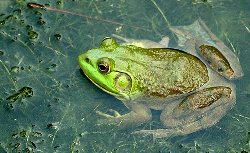Interactions
The tiger salamander is classified to be a secondary consumer
because it consume s
snails, insects slugs, and worms in addition to baby snakes,
mice, frogs, and other smaller salamanders, and it is consumed
by bullfrogs, crayfish, and fish.
s
snails, insects slugs, and worms in addition to baby snakes,
mice, frogs, and other smaller salamanders, and it is consumed
by bullfrogs, crayfish, and fish.
Parasite Interactions :
Ambystoma tigrinum virus causes recurrent epidemics in the aquatic, primarily larval stage of tiger salamander populations throughout the Plains and Intermountain West in North America. ATV (Ambystoma Tigrinum Virus) infections are usually highly irulent— most infected animals succumb to ATV infection (case mortality is usually around 90%) and die within 2–3 weeks. However, like most parasites, ATV is not universally virulent. Survival times of salamanders exposed to ATV under similar conditions vary over two weeks and case mortality can be as low as 40% and as high as 100% . In addition, salamanders that survive experimental ATV infections can remain asymptomatically infected, and infective to others over 5 months after initial exposure. These chronic infections seem to be important for the persistence of ATV between annual die-offs in nature. The question as to why some salamanders die quickly, others survive longer, and still others maintain chronic infections indefinitely, is key to understanding the dynamics of ATV, and perhaps other pathogens.
Predator Interactions:
 Principal threats to the Sonoran Tiger Salamander include a) introduced
non-native predators in the form of
bullfrogs, crayfish,
and
fish, b) genetic swamping with other forms of tiger
salamanders released as unwanted live bait by anglers
into the populations, and c) infectious disease in the
form of a highly lethal iridiovirus. There is also
accumulating evidence that other populations of Tiger
Salamanders may also be susceptible to such viruses, and
these can effect mass mortalities of larvae leading to
local population declines and/or disappearances.
Principal threats to the Sonoran Tiger Salamander include a) introduced
non-native predators in the form of
bullfrogs, crayfish,
and
fish, b) genetic swamping with other forms of tiger
salamanders released as unwanted live bait by anglers
into the populations, and c) infectious disease in the
form of a highly lethal iridiovirus. There is also
accumulating evidence that other populations of Tiger
Salamanders may also be susceptible to such viruses, and
these can effect mass mortalities of larvae leading to
local population declines and/or disappearances.
If you would like to learn fascinating and unique facts about the tiger salamander click here
To go back and learn about the reproduction of tiger salamanders click here.
To go back to the home page click here.